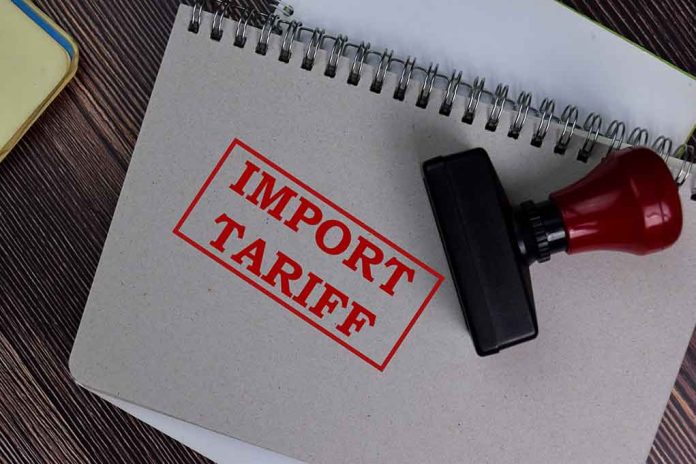🔴 Website 👉 https://u-s-news.com/
Telegram 👉 https://t.me/usnewscom_channel
Trump’s liberation day tariffs exempted Russia, North Korea, and certain other countries not because he favors them, but because they’re already facing high tariffs and significant sanctions that limit meaningful trade.
At a Glance
- President Trump imposed “Liberation Day” tariffs with a 10% baseline on most nations but exempted Russia, North Korea, Cuba, and Belarus
- White House officials explained the exemptions are due to existing high tariffs and sanctions already limiting trade with these countries
- Countries like Iran and Syria still received tariffs of 10% and 40% respectively despite also facing sanctions
- The tariffs are described as temporary measures to address trade deficits and support American manufacturing
- Trump utilized the International Emergency Economic Powers Act of 1977 to establish these new trade measures
Existing Sanctions Make Additional Tariffs Redundant
President Trump’s recent introduction of sweeping “Liberation Day” tariffs has raised eyebrows due to the notable absence of Russia, North Korea, and several other nations from the list. While some critics might hastily jump to politically-motivated conclusions, the White House has provided a clear and logical explanation for these exemptions. The countries in question — Russia, North Korea, Cuba, and Belarus — are already subject to extensive sanctions and high tariff rates that effectively limit trade, making additional tariffs unnecessary and largely symbolic.
White House press secretary Karoline Leavitt confirmed this reasoning, stating that these nations were excluded precisely because existing sanctions already heavily restrict trade relations. This stands in stark contrast to nations like China and Mexico, which maintain significant trade relationships with the United States despite imposing their own barriers on American goods. The administration’s approach targets countries where reciprocal measures can actually influence trade behavior rather than those where trade is already minimal due to sanctions.
Addressing America’s Trade Deficit Crisis
The broader context of these tariffs reveals President Trump’s strategic approach to what the White House has characterized as a national emergency affecting America’s manufacturing base. Foreign trade practices have led to substantial trade deficits, which in turn have reduced incentives for domestic manufacturing and created dangerous dependencies on foreign supply chains. Trump’s tariff structure, which establishes a baseline 10 percent tariff with escalating rates for countries with significant trade surpluses against the United States, aims to restore balance and fairness to international trade.
It’s worth noting that despite also facing sanctions, countries like Iran and Syria were not exempted and will face tariffs of 10% and 40% respectively. This selective approach underscores the administration’s focus on calibrating tariffs based on specific trade relationships rather than applying a one-size-fits-all policy. The White House has emphasized that these measures are temporary and will remain in place until the trade deficit threat is adequately addressed or mitigated, aligning with Trump’s longstanding economic vision of reciprocity in trade relations.
Restoring American Manufacturing Through Reciprocal Trade
President Trump’s tariff strategy represents a continuation of policies he championed during his first term, when he successfully utilized tariffs to boost domestic manufacturing and apply pressure on trading partners engaged in unfair practices. The current implementation, authorized under the International Emergency Economic Powers Act of 1977, establishes an initial wave of tariffs taking effect on April 5, with additional targeted measures for high-deficit countries beginning April 9. This phased approach allows for strategic adjustments while sending a clear message about America’s commitment to fair trade.
The White House has emphasized Trump’s distinction as the first modern president to demand genuinely reciprocal treatment from trading partners. This approach rejects the decades-long acceptance of unbalanced trade relationships that have hollowed out American manufacturing communities. By linking tariffs directly to the behaviors of trading partners, the administration creates powerful incentives for countries to reduce their own barriers to American goods while simultaneously protecting domestic industries from unfair foreign competition.
A Temporary Measure With Long-Term Goals
Critics who’ve seized on the Russia and North Korea exemptions as somehow indicating favoritism are missing the fundamental economic logic behind these decisions. The administration has repeatedly emphasized that the entire tariff framework is designed as a temporary corrective measure, not a permanent feature of American trade policy. Once trading partners adjust their practices and meaningful progress is made in reducing trade deficits, these tariffs are intended to be scaled back or eliminated entirely, fostering a more balanced global trading system built on genuine reciprocity.
President Trump’s approach represents a sharp break from decades of American trade policy that often prioritized diplomatic considerations over economic interests. By focusing specifically on nations with which the United States maintains active trade relationships while excluding those already facing comprehensive sanctions, the administration maximizes leverage where it counts while avoiding redundant measures. This pragmatic approach underscores Trump’s commitment to rebuilding American manufacturing through strategic trade policies rather than empty gestures.

